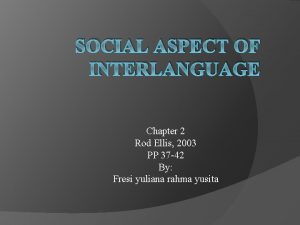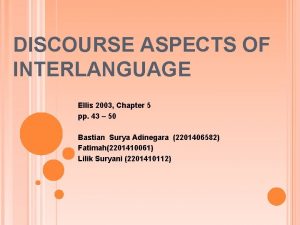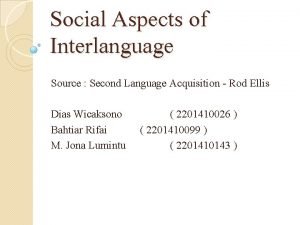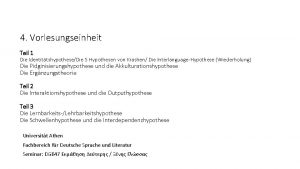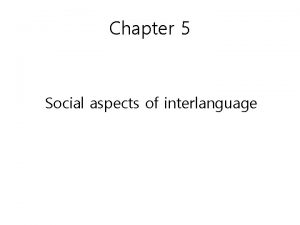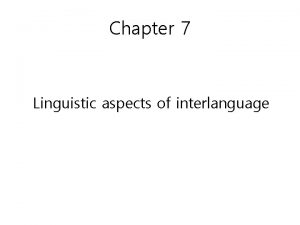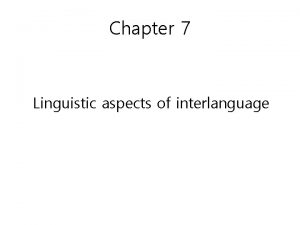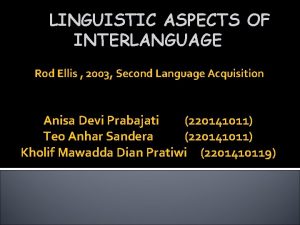Chapter 6 Psycholinguistic aspects of interlanguage Q L




















- Slides: 20

Chapter 6 Psycholinguistic aspects of interlanguage

Q: L 1 transfer positive vs. negative?

Q: L 1 transfer (p. 52) ü in the mentalist view ü in the cognitivist view ü in the behaviorist view

Cross-linguistic Influence: The Semantic Dimension ¢ Ø Ø Ø Ø ¢ Ø Ø Expansion (generalization) burberry coat(trench coat) coating(laminating) hip (rear, bottom or buttocks) Narrowing sign (signature or autograph) manicure(nail polish) glamour(a girl with a sexy figure) Innovation booking (an instant blind date) fighting!(go for it! or hurray!) magic pen (marker) meeting(blind date) one shot (bottoms-up!) open car (convertible) skinship(casual contact between lovers) Pejoration hostess (a woman who works at an adult bar) room salon(an adult bar)

Cross-linguistic Influence: The Collocational Dimension Ø strong drinker (heavy drinker) Ø sour and sweet (sweet and sour) Ø East, West, South, North (North, South, East, West) Ø 3 nights 4 days (4 days 3 nights)

Cross-linguistic Influence: The Conceptual Dimension (1) Language shapes the conceptual categories that influence how its speakers’ perceptions are encoded and stored (Wierzbicka, 1992). English-speakers narrate an event from their point of view Ø Where am I ? Ø I like your dress Konglish users describe it from a third-person perspective as an observer Ø Where is here? Ø Your dress is beautiful Speaker-orientation Ø Can I get some water? Hearer-orientation Ø Could you bring me some water? Ø Please bring me some water

Cross-linguistic Influence: The Conceptual Dimension (2) Underlying concepts profoundly affect the meanings attached to linguistic labels. Even in domains where two languages seem to divide the world up conceptually in broadly the same way, linguistic labels are often applied in different places (Swan, 1997). Ø half-boiled egg vs. soft-boiled egg Ø The respondent’s intention is in accordance with the true value “I am not hungry” Q: Aren’t you hungry? A: Yes

Cross-linguistic Influence: The Metaphorical Dimension § Metaphorical concepts and features are culture-specific (Lakoff & Johnson, 1980). § Certain features specifically emphasized and valued in the given culture affect the process of elaboration of metaphorical expressions (Kövecses, 2002, p. 186). Ø Turtle (snail) Ø Stone head (air head)

Cross-linguistic Influence: The Pragmatic Dimension § “Free” goods (Lakoff, 1974) Ø marital status and age § “Noticing”, especially lying in compliments in native speakers’ greetings (Hatch, 1984, p. 191) Ø Where are you going? Ø Did you eat your meal?

Q: The role of consciousness (p. 55) Ø Krashen’s view Ø Schmidt’s view

Q: Explicit v s. Implicit knowledge (pp. 56 -57) “Do you know how to dance? ”

Explicit knowledge Ø "knowing that” Ø known as data, stored as information Implicit knowledge Ø "knowing how" Ø knowledge of how to go about doing something, Ø knowledge that we may or may not be able to describe explicitly

Communication strategies: Achievement strategies To reach the communicative goal by expanding the communicative resources at one’s disposal in order to compensate for their linguistic insufficiency Ø (over)-generalization, Ø paraphrase, Ø code switching

Reduction strategies To avoid problems by reducing one’s communicative goal Ø topic avoidance- as a form of refusal of certain topics requiring specific language features beyond the learner’s linguistic ability Ø semantic avoidance (meaning replacement) uttering in a somewhat different way from the speaker’s original intention in order to avoid certain linguistic elements Ø message abandonment -to discontinue an utterance which is already underway

L 1 -based Ø language switch and literal translation IL(L 2)-based strategies Ø Paraphrase, generalization, word coinage, and restructuring ü L 2 -based strategies, circumlocution (paraphrase) or approximation --- preferred by more proficient learners

PSM: Problem-solving mechanism


Discrete serial models (e. g. Levelt 1989) Semantic node ----- o o Lexical node ----- o o Sublexical node ----- o o

Mental lexicon Semantic Lexical Sublexical Semantic o o coffee kɔ: fi 커피 kɔ: pi Lexical Sublexical o o o 깁스 gibs o o

Connectionist view (Parallel distributed processing) (e. g. Dell 1989, 2000; Costa, Caramazza & Sebasti´an-Gall´es 2000) Semantic node ----- o o Lexical node ----- o o Sublexical node ----- o o
 Psycholinguistics aspects of interlanguage
Psycholinguistics aspects of interlanguage Psycholinguistic aspects of interlanguage
Psycholinguistic aspects of interlanguage Psycholinguistic aspects of interlanguage
Psycholinguistic aspects of interlanguage Psycholinguistic aspects of interlanguage
Psycholinguistic aspects of interlanguage Interlanguage and social identity and investment
Interlanguage and social identity and investment Interlanguage and stylistic continuum
Interlanguage and stylistic continuum Discourse aspects of interlanguage
Discourse aspects of interlanguage Undelies
Undelies Apat na proseso ng pagbasa ayon kay william gray
Apat na proseso ng pagbasa ayon kay william gray Psycholinguistic guessing game
Psycholinguistic guessing game Teoryang interlanguage
Teoryang interlanguage What is interlanguaging
What is interlanguaging Rod ellis
Rod ellis Interlanguage hypothese
Interlanguage hypothese Contrastive analysis error analysis and interlanguage
Contrastive analysis error analysis and interlanguage Interlanguage sla
Interlanguage sla Acculturation model and accommodation theory of sla
Acculturation model and accommodation theory of sla Interlanguage hypothese kritik
Interlanguage hypothese kritik Interlanguage as explained by the mentalist learning theory
Interlanguage as explained by the mentalist learning theory Interlanguage hypothese kritik
Interlanguage hypothese kritik Selinker
Selinker





